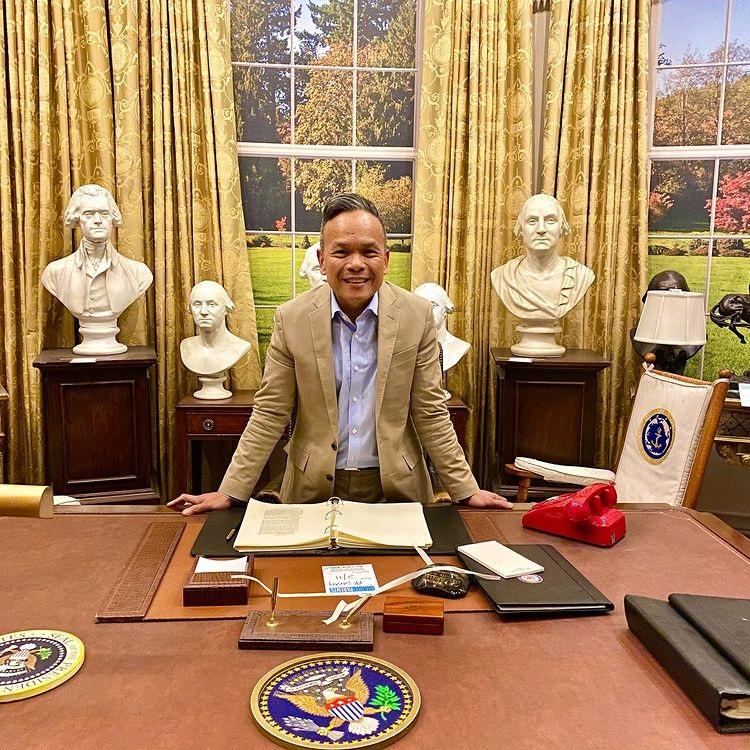IN A University of Minnesota news feature, Professor Lawrence Que Jr. was referred to as “Iron Man” when he was awarded the prestigious Inorganic Mechanisms 2011 Award in May of this year from the Royal Society of Chemistry (RSC) for his contributions to the mechanistic understanding of dioxygen activation, by nonheme iron enzymes.
The Royal Society of Chemistry is the largest organization in Europe, committed to advancing the chemical sciences. The RSC awards honor scientists whose careers are defined by exceptional work, excellence, and dedication.
The same news feature, written by Deane Morrison, said that Lawrence Que Jr., a Regents Professor (the University’s highest faculty rank) of Chemistry, is “one of the world’s foremost experts on iron-containing enzymes…(he) studies iron-containing enzymes that scientists would love to mimic to save energy and even lives.”
During the past several decades, research performed by Que has changed the way scientists think about the chemistry of nonheme iron proteins and complexes. It has placed him among the world’s most prolific and important practitioners of bio-inorganic chemistry.
Que’s work on “nonheme iron” enzymes could lead to better treatments for maladies like Parkinson’s or even cancer; to making antibiotics or to repair damaged DNA in cells.
But nonheme iron enzymes also perform the crucial first step in the production of industrial chemical feedstocks from methane gas. That talent, if harnessed, could mean enormous energy savings for industry.
In July 2011, Que was elected a 2011 Fellow of the American Chemical Society (ACS). This designation honors those who have distinguished themselves in multiple areas, including promoting the science and the profession of chemistry, and service to the American Chemical Society.
Born and raised in Manila, Philippines, Lawrence or Larry, as friends call him, received a BS in Chemistry in 1969 from Ateneo de Manila University, Philippines, and a Ph.D. in Chemistry in 1973 from the University of Minnesota.
He joined the faculty at Cornell University in 1977, then moved to the University of Minnesota in 1983.
He is considered to be an internationally-acclaimed scholar, who has made a tremendous impact in the field of bio-inorganic chemistry. He has played a pioneering role in understanding the function that nonheme iron centers play in dioxygen activation in biology.
“Undoubtedly, Professor Que is currently the top bio-inorganic chemist in the world. In his chosen field, oxygen activation of iron-containing enzymes and biomimetic compounds, his group, in my estimation, is at least three years ahead of his closest competitors. Almost single-handedly he has developed the major fraction of the synthetic chemistry of iron in high oxidations states. This chemistry is vital to our understanding of many processes in biochemistry, to the development of new drugs, and most importantly, to developing a green chemistry that can alleviate the problems caused by pollutants and pathogens that afflict human health,” says University of Minnesota’s website during the awarding.
His service to the University is notable. He is credited with establishing the University of Minnesota as a world-renowned center of excellence in bio-inorganic chemistry. He organized the International Conference on Oxygen Intermediates in Nonheme Metallobiochemistry (1996) and the Ninth International Conference on Biological Inorganic Chemistry (1999).
He also led the effort to establish the University of Minnesota Center for Metals in Bio-catalysis, which is comprised of faculty and students from multiple departments who share interests in exploring the roles of metals in biology.
Que authored over 400 publications; presented 290 invited lectures, including 22 plenary, keynotes, or endowed lectureships. He is also the chief editor of the Journal of Biological Inorganic Chemistry.
A number of his most recent findings have been published in Science, the premier international scientific journal.
He is the recipient of numerous awards and honors including the University of Minnesota Award for Outstanding Contributions in Post-Baccalaureate, Graduate, and Professional Education, the MERIT Award from the National Institute of Health, the Frontiers in Biological Chemistry Award from the Max-Planck-Institute for Bio-inorganic Chemistry (2005), election as a Fellow of the American Association for the Advancement of Science (2001), and the Alfred Bader Award for Bio-inorganic and Bio-organic Chemistry from the American Chemical Society in 2008 (the premier award in his field). His latest honors are the Inorganic Mechanisms 2011 Award from the Royal Society of Chemistry (RSC), and the election as a Fellow of the American Chemical Society (ACS).
Undoubtedly, Que’s outstanding work and achievements in his field are well recognized by people around the world. One of his closest colleagues in the University of Minnesota, biochemistry professor John Lipscomb, says of him, “Larry is right at the pinnacle of this field worldwide,” calling Que’s synthesized models his ‘masterworks.’ “We need people like Larry,” he added.
And the University of Minnesota certainly agrees as their website proudly states, “We are indeed fortunate to have Professor Que as part of our intellectual community.”
(www.asianjournal.com)
(LA Weekend Oct 1-4, 2011 Sec A pg.10)





